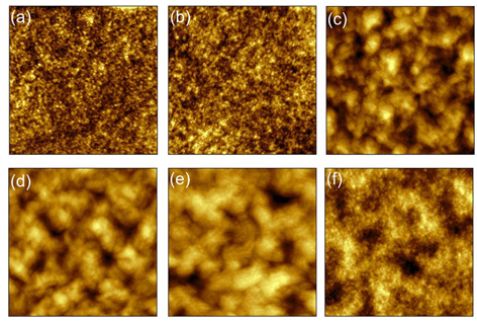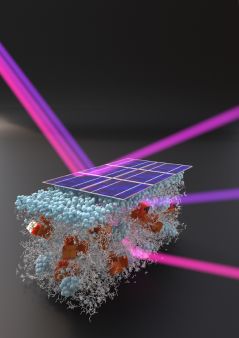MLZ is a cooperation between:
 > Technische Universität München
> Technische Universität München > Helmholtz-Zentrum Hereon
> Helmholtz-Zentrum Hereon
 > Forschungszentrum Jülich
> Forschungszentrum Jülich
MLZ is a member of:
 > LENS
> LENS > ERF-AISBL
> ERF-AISBL
MLZ on social media:

MLZ (eng)
Lichtenbergstr.1
85748 Garching
15.11.2018
Neutrons explain higher efficiency of solar cells with additives
Organic solar cells are cheaper to produce than conventional photovoltaic systems and can even be sprayed as thin layers on any surfaces. They have been the subject of intensive research since the Nobel price was awarded for conducting polymers in 2000. Physicists at the Technical University of Munich (TUM) have now been able to clarify why additives increase the efficiency of solar cells from a morphological point of view with the use of neutrons at the Heinz Maier-Leibnitz Zentrum (MLZ).
In solar cells charge carriers are generated at the interface between acceptor and donor materials forming the active layer of the solar cell. These charge carriers collected at the electrodes give the current originating from the conversion of sun light.
Organic solar cells consist of hydrocarbon compounds. These plastic solar cells have so far achieved efficiencies up to 13% converting solar energy into electrical energy. On a first view these numbers appear to be low as compared to highly optimized inorganic photovoltaic systems (up to 43%), but one needs to consider that plastic solar cells are a rather young research area.
Scientists at the Chair of Functional Materials at Physics Department of TUM have been researching organic photovoltaic cells since several years. As neutrons provide information about the inner film structures in the plastic compounds, they use the MLZ. The group of Prof. Dr. Peter Müller-Buschbaum is especially interested in the question, why some solvent additives, such as 1,8-octanedithiol (ODT), in the active layer increase the performance of plastic solar cells. “Just a few percent of this additive can dramatically increase efficiency”, explains Dr. Lin Song, Post-Doc at the Chair of Functional Materials. Until now, scientists typically had only studied surface structures using microscopic methods. However, it had already been found that surface and inner morphology differ significantly.

Atomic force microscopic images show the different structures in films without additive (a) and with increasing concentration of the additive ODT (b-f). © TUM
Neutrons are the tool of choice to look deeper into the mysterious inner morphology and find out how the additive modifies structures. Dr. Weijia Wang and Dr. Lin Song investigated these questions at the neutron reflectometer REFSANS of the MLZ. They added various concentrations of the additive ODT. Instrument scientist Dr. Jean-Francois Moulin from the Helmholtz-Zentrum Geesthacht used the so-called grazing incidence small angle neutron scattering (GISANS) in the study. “Combined with the time-of-flight (TOF) method, which is the exciting mode at REFSANS, we got completely new insights into the inner structure and surface structure”, says Lin Song.
The results showed that the surface and interior of the intermediate layer are similar without the additive ODT and some isolated nano-islands had formed. “The charge carriers are trapped in these islands”, Lin Song explains the results. In contrast, the structure with the additive ODT is quite different: there are less traps, the interconnections are much better developed and thus charge carries can be transported more efficiently.
However, there is a limit beyond which an additional additive does not increase efficiency. The neutrons were also able to show this: if the concentrations are too high, the ODT induces a compact layer of acceptors on the surface. Now surface and inner structures differ. “We have now explained for the first time from the molecular level, why the efficiency cannot increase further”, says Weijia Wang. Atomic force microscopy and X-rays support these results.
Original Publication:
Weijia Wang, Lin Song, David Magerl, Daniel Musegui González, Volker Körstgens, Martine Philipp, Jean-Francois Moulin, and Peter Müller-Buschbaum
Advanced Functional Materials, 2018, 1800209,
DOI: 10.1002/adfm.201800209
MLZ is a cooperation between:
 > Technische Universität München
> Technische Universität München > Helmholtz-Zentrum Hereon
> Helmholtz-Zentrum Hereon
 > Forschungszentrum Jülich
> Forschungszentrum Jülich
MLZ is a member of:
 > LENS
> LENS > ERF-AISBL
> ERF-AISBL
MLZ on social media:



